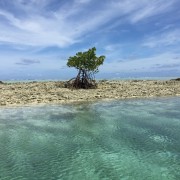Speeches Shim

Pacific Island countries are highly vulnerable to the negative effects of climate change. More than 8.5 million people across the region depend for their livelihood primarily on tourism, fisheries, forestry and agriculture, all of which are highly sensitive to rising sea levels, changing ocean temperatures and acidity, and shifting rainfall and storm patterns. Civil society organizations (CSOs), which play a critical role in the region’s social and economic development, are often hindered by a lack of resources and managerial capacity from responding to climate change challenges.
USAID has partnered with Arizona State University (ASU) under the Vocational Training and Education for Clean Energy (VOCTEC) program to build regional capacity of qualified technical trainers and technicians to install, operate, and troubleshoot off-grid solar photovoltaic (PV) systems in the Pacific Islands.
USAID’s five-year Disaster Preparedness for Effective Response (PREPARE) program follows the Disaster Mitigation, Relief, and Reconstruction Program (DMRRP), in which the International Organization for Migration (IOM) established an operational and logistics presence in five locations in the two countries. This entailed pre-positioning humanitarian relief supplies and equipment and enhanced standby capacity for logistics, medical response and reconstruction of housing and public infrastructure. After facilitating USAID’s response to the 2013 drought in the Marshall Islands, the DMRRP closed in late 2014.
On April 28, 2015, U.S. President Barack Obama issued a Presidential Disaster Declaration after the Federated States of Micronesia (FSM) was severely damaged by Typhoon Maysak, which passed through Chuuk and Yap States between March 29 and April 1, 2015. Under the terms of the Compact agreement between the United States and the Government of FSM, the Declaration mobilized U.S. federal funding for immediate emergency relief and reconstruction assistance.

Comment
Make a general inquiry or suggest an improvement.